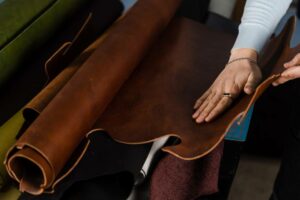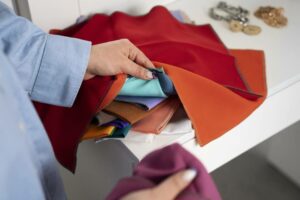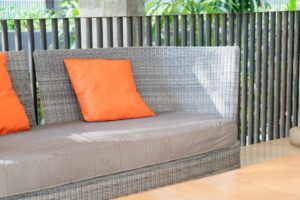In the diverse and constantly evolving synthetic leather market in Malaysia, the ongoing debate between PU leather vs PVC leather remains a central topic of discussion.
Each type of leather offers a distinct set of properties, making it essential to comprehend their differences in order to make well-informed decisions.
Whether you’re evaluating factors such as durability or texture, this article delves deep into their unique characteristics and the most suitable applications for each.
What is Synthetic Leather?
In the world of upholstery and manufacturing, synthetic leather holds a significant place, offering a cruelty-free and versatile alternative to traditional leather.
The most prominent types of synthetic leather are Polyurethane (PU) leather and Polyvinyl Chloride (PVC) leather. Each synthetic leather comes with its unique composition, characteristics, and ideal uses.
What is PU Leather?

PU leather, also known as Polyurethane leather, is made by coating a fabric base with a layer of polyurethane.
This application process is instrumental in endowing PU leather with its distinctive texture, flexibility, and breathability.
1. Benefits of PU Leather
One of the notable attributes of PU leather is its superior flexibility and its naturally soft texture when compared to synthetic alternatives.
Furthermore, its breathability significantly enhances comfort, making it a highly sought-after choice for a wide range of applications.
2. Disadvantages of PU Leather
However, despite its array of benefits, PU leather does come with its set of challenges.
It tends to be less durable and is notably susceptible to wear and tear over time.
This is particularly true when exposed to harsh environmental conditions or subjected to constant use, such as Malaysia’s hot and humid weather or commercial usage.
Given this characteristic, it becomes crucial to carefully consider the material’s longevity in applications where durability is a critical factor.
3. Industry Applications
In terms of applications, the texture and flexibility of PU leather make it an ideal material for fashion-forward items, creating a sense of luxury and comfort.
It’s also a top pick for upholstery, particularly for furniture where comfort is paramount, and for breathable footwear, providing a pleasant experience for the wearer.
What is PVC Leather?

PVC leather, or Polyvinyl Chloride leather, is a type of synthetic leather that is manufactured by applying a PVC coating to a fabric base.
This base layer is subsequently treated with various additives, which are essential in developing its unique texture and enhancing its durability.
1. Benefits of PVC Leather
PVC leather is renowned for its outstanding durability. Its capacity to repel water renders it indispensable in situations where contact with liquids is frequent.
Furthermore, PVC leather stands out as a cost-effective choice, making it attractive to a wide array of industries that prioritise both quality and affordability.
It is also highly resistant to water, making it suitable for many different usages and industries.
2. Disadvantages of PVC Leather
PVC leather, however, is less breathable due to its water-resistant properties. Hence, it may be uncomfortable for some.
Moreover, there are significant environmental concerns associated with PVC leather, particularly concerning its manufacturing process and the difficulties associated with its disposal.
These concerns arise from the emission of harmful chemicals during production and the non-biodegradable nature of the material, which contributes to its reduced environmental friendliness.
3. Industry Applications
Regarding applications, the inherent durability and water-resistant characteristics of PVC leather make it a preferred choice for a myriad of products. This includes but isn’t limited to:
- Crafting outdoor furniture that can withstand the elements.
- Designing car interiors that require a blend of luxury and resilience.
- Producing book bindings that demand longevity.
- Handbags, backpacks and wallets.
Read More: Fabric for Sofa: Ultimate Guide to Selecting the Best Material
PU Leather vs PVC Leather: A Detailed Comparison

Diving into the specifics, PU leather and PVC leather differ greatly in terms of feel, durability, care, and sustainability.
PU leather, renowned for its softer texture and breathability, brings a luxurious feel that’s hard to match, making it an ideal choice for products that prioritise comfort and aesthetic appeal.
On the other hand, PVC leather is highly esteemed for its formidable durability and water-resistant properties, positioning it as a go-to material for products that demand resilience and longevity.
Unfortunately, both materials have their challenges when it comes to environmental impact.
While PU leather might have a lesser environmental impact compared to PVC, both manufacturing processes still involve chemicals that can contribute to pollution and resource depletion.
However, advancements in recycling technologies are offering new possibilities for managing PU and PVC leather waste more effectively, thereby addressing the concerns related to its disposal.
Making the Right Choice: PU Leather vs PVC Leather

Choosing between PU leather vs PVC leather requires thoughtful consideration of various factors such as:
1. Usage
If your products demand a softer and more luxurious feel, it is best to choose PU leather.
For items requiring high durability and water resistance, PVC leather is the go-to option.
That said, it is important to note that today’s technology has successfully allowed PVC to achieve the softness of PU Leather.
2. Budgetary Considerations
While both materials are generally more affordable than genuine leather, PVC leather is often more cost-effective.
3. Assess Water Resistance
For applications where the material may come into contact with liquids or needs to be water-resistant, PVC leather is the better option due to its strong water-resistant properties.
4. Durability
If your application demands high durability and resistance to wear and tear, PVC leather is a solid choice. It’s known for its toughness and can withstand heavy use.
Read More: Pocket Spring Sofa: Your Complete Guide to Sofa Springs
High-Quality Synthetic Leather with Kintex
In conclusion, whether you prefer PU leather or PVC leather, making an informed decision ensures alignment with your brand’s needs, values, and aesthetic preferences.
No matter your choice, as the leading synthetic leather supplier in Malaysia, Kintex provides a wide variety of PVC and PU leather collections that would suit your needs.







